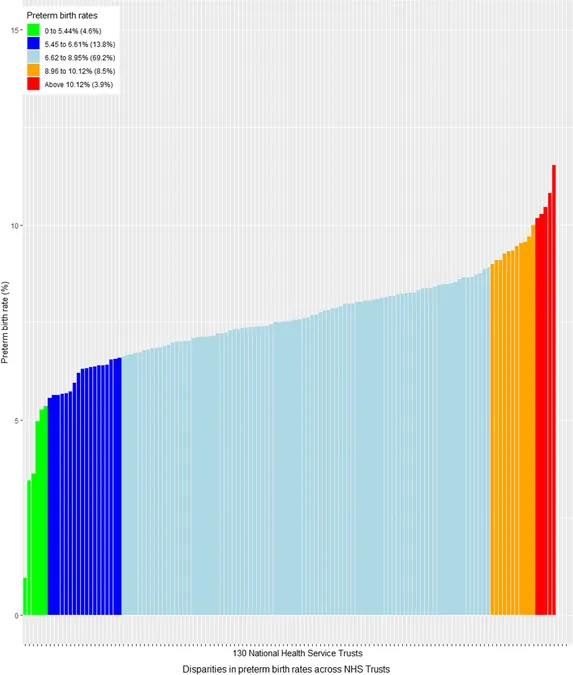
Alarming Socioeconomic and Ethnic Disparities in Preterm Birth Rates Across England: Unveiling the Hidden Crisis in Maternity Care
2024-09-20
Introduction
Preterm birth remains a significant contributor to infant mortality and long-term health issues, accounting for 7-8% of births in the UK. Emerging evidence indicates that women from socioeconomically disadvantaged backgrounds and minority ethnic groups are disproportionately affected, pointing to a concerning health inequality trend. This extensive study, which analyzed data from 1.3 million births in England, sought to uncover the reasons behind these disparities in preterm birth rates, a condition defined as childbirth occurring before 37 weeks of gestation.
Study Details
Researchers employed a robust methodology, utilizing NHS maternity care records of live births from April 2015 to March 2017 across 130 Health Trusts in England. By applying modified Poisson regression techniques, they determined the risk ratios attributed to ethnicity and socioeconomic status for preterm births.
Key Findings
1. Dramatic Disparities in Rates: The findings revealed a stark contrast in preterm birth rates by socioeconomic status. Women in the most deprived areas faced a rate of 8.8 preterm births per 100 births, compared to only 6.8 per 100 in the least deprived neighborhoods. Ethnic disparities emerged equally striking, where black women showed a preterm birth rate of 8.6 per 100 compared to 7.8 for white women.
2. Impacts of Area Variability: Interestingly, certain Health Trusts exhibited a paradoxical trend, reporting low preterm birth rates among white women while simultaneously recording high rates among black and Asian women. This suggests that access to and quality of maternity care could be influenced by both ethnicity and socioeconomic conditions.
3. Global Context: Preterm birth rates are not just a localized issue; they are rising globally, with European nations witnessing similar trends. Alarmingly, while Europe only accounts for 4.7% of the worldwide preterm birth burden, over 50,000 cases are reported annually in the UK alone.
4. National Response: In light of these disparities, the UK Secretary of State for Health has pledged to reduce the preterm birth rate from 8% to 6% by 2025. This initiative has led to the revision of the Saving Babies’ Lives Care Bundle, emphasizing the need for Integrated Care Boards to adopt better practices for preventing premature births among at-risk populations.
5. Underlying Causes: The study presents evidence of socioeconomic factors as critical determinants of preterm birth. Women in lower economic strata face multiple barriers to adequate maternal care, including social inequities, lack of access to health services, and increased health risks.
Conclusion and Implications for Future Research
The findings indicate a pressing need for targeted health interventions aimed at understanding and mitigating the causes of these disparities. The issues at play are multifaceted, tying back to broader societal challenges such as educational disparities, healthcare access, and socioeconomic status. Effective solutions will require an intersectional approach addressing the unique needs of different ethnic groups and socioeconomic classes to ensure equitable healthcare experiences for all mothers.
Given the significant regional disparities seen, it is crucial for policymakers and healthcare providers to collaborate in developing strategies that not only recognize these disparities but actively work towards reducing them. Enhanced community engagement and tailored healthcare provision could pave the way for improved outcomes for mothers and infants alike, ultimately contributing to a healthier future generation.
What Can You Do?
Stay informed, advocate for policy change, and support initiatives aimed at elevating maternal health standards for disadvantaged populations. Together, we can make a difference in combating the hidden crisis of preterm births in our communities!


 Brasil (PT)
Brasil (PT)
 Canada (EN)
Canada (EN)
 Chile (ES)
Chile (ES)
 España (ES)
España (ES)
 France (FR)
France (FR)
 Hong Kong (EN)
Hong Kong (EN)
 Italia (IT)
Italia (IT)
 日本 (JA)
日本 (JA)
 Magyarország (HU)
Magyarország (HU)
 Norge (NO)
Norge (NO)
 Polska (PL)
Polska (PL)
 Schweiz (DE)
Schweiz (DE)
 Singapore (EN)
Singapore (EN)
 Sverige (SV)
Sverige (SV)
 Suomi (FI)
Suomi (FI)
 Türkiye (TR)
Türkiye (TR)